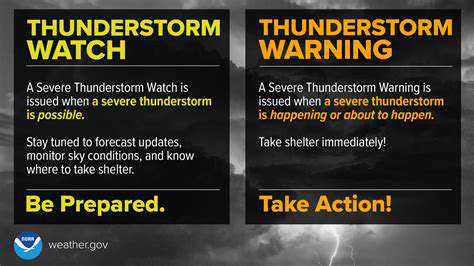Severe Thunderstorm Watch: What to Do, Safety Tips & Weather Updates
List of Contents
Watches signal potential storms; Warnings mean immediate danger is present.
Remain indoors during electrical storms; stay clear of glass and find solid shelter if caught outside.
Maintain emergency supplies with fresh water, canned goods, and critical items; rotate stock quarterly.
Leverage apps for live tracking; emergency radios deliver non-stop storm data even when power fails.
Join neighborhood safety initiatives to improve collective readiness and crisis management.
What to Do When a Severe Thunderstorm Watch is Issued
Decoding Weather Alerts: Watches vs. Warnings
A Severe Thunderstorm Watch acts as nature's amber light - it means conditions could spawn dangerous storms, but none have formed yet. This early heads-up allows smart preparation without panic. I've seen many confuse this with immediate danger, leading to unnecessary stress.
When warnings blare, that's your red alert. These mean trained spotters or radar have confirmed baseball-sized hail or 70mph winds in your area. During my time volunteering with emergency services, we'd always emphasize: Warnings demand instant action - shelter now, questions later.
Fortifying Your Home Against Nature's Fury
Storm prep starts long before clouds darken. Secure patio furniture that could become missiles in 60mph gusts. Install storm shutters or pre-cut plywood for windows. An overlooked tip: clean gutters quarterly to prevent water backup during torrential rains.
Your emergency kit needs more than just flashlights. After the 2023 Midwest derecho, survivors wished they'd packed:
- Power banks for medical devices
- Cash (ATMs fail when power does)
- Hard copies of insurance policies
Real-Time Information Strategies
During a watch, I set up my weather war room:
- NOAA Weather Radio on charger
- Local news streaming on tablet
- RadarScope app tracking storm cells
Shelter Science: Where to Ride Out the Storm
Basements offer best protection, but most homes lack them. Create an interior safe zone:
| Room Type | Safety Rating |
|---|---|
| Windowless bathroom | ★★★★☆ |
| Center hallway | ★★★☆☆ |
| Walk-in closet | ★★★☆☆ |
After the Storm: Smart Recovery Tactics
Post-storm inspection requires caution:
- Wear sturdy shoes - hidden nails abound
- Use camera timestamps for insurance claims
- Photograph damage before moving anything
Safety Tips During a Severe Thunderstorm
Alert System Mastery
Weather alerts work best when personalized. Enable location tracking in apps - county-wide alerts often cover 800+ square miles. Set distinct ringtones for warnings - during sleep, a blaring siren tone beats gentle chimes.
Shelter Psychology
Safe spaces need mental prep too. Practice shelter drills with kids monthly. Stock the area with:
- Glow sticks (safer than candles)
- Distraction toys for children
- Ear protection for noise-sensitive family
Emergency Kit Evolution
Modernize your Emergency Kit:
- Swap canned foods for freeze-dried meals
- Include USB-rechargeable devices
- Add laminated emergency contacts
Information Verification Tactics
Combat misinformation with the Triple Check Rule:
- Official weather service alert
- Local broadcaster confirmation
- Trusted meteorologist social post
Post-Storm Community Care
Recovery requires teamwork:
| Time Frame | Action |
|---|---|
| First Hour | Check on elderly neighbors |
| Day 1 | Organize debris cleanup crews |
| Week 1 | Host preparedness workshops |
The Danger of Severe Thunderstorms

Storm Science Simplified
Three ingredients brew severe storms:
- Moisture - Gulf air meets dry currents
- Instability - Rapidly rising warm air
- Lift - Fronts or terrain forcing ascent
Warning Recognition Guide
Decode alerts like a pro:
- PDS in warnings = Particularly Dangerous Situation
- TORCON scores = Tornado likelihood (1-10)
- MCD codes = Meteorological Discussion
Advanced Safety Protocols
Beyond basics:
- Install lightning surge protectors
- Anchor fuel tanks to slabs
- Mark underground utilities
Economic & Human Impacts
2023 storm costs shocked insurers:
| Damage Type | Average Claim |
|---|---|
| Hail | $12,000 |
| Wind | $8,500 |
| Water | $25,000+ |
Tech-Driven Preparedness
Modern tools revolutionize safety:
- AI-powered weather apps
- Smart home water sensors
- Crowdsourced damage maps
Staying Updated on Weather Conditions

Alert Customization Techniques
Optimize notifications:
- Set 20-mile radius alerts
- Enable destructive warning tags
- Mute non-essential alerts
Field Guide for Outdoor Workers
When storms threaten jobsites:
- Designate weather watcher roles
- Establish safe zones every 200 feet
- Conduct 15-minute radar checks
Smart Home Weather Integration
Automate safety:
| Device | Storm Function |
|---|---|
| Smart speakers | Voice alerts |
| Security cams | Wind damage detection |
| Leak sensors | Flood warnings |
Post-Event Analysis Habits
After each storm:
- Review response timeline
- Update evacuation routes
- Refresh emergency contacts
Building Weather-Wise Communities
Launch neighborhood initiatives:
- Storm spotter training
- Tree risk assessments
- Emergency skill swaps
Read more about Severe Thunderstorm Watch: What to Do, Safety Tips & Weather Updates
Hot Recommendations
- Duke Basketball: A Legacy of Excellence – Season Recap and Future Stars
- One Battle After Another: Stories of Overcoming Challenges and Triumphs
- MLB Games Tonight: Schedule, Scores & Key Matchups to Watch
- Men’s March Madness 2025: Expert NCAA Bracket Predictions & Winning Strategies
- Spring Equinox 2025 Celebrations: History, Traditions, and How to Enjoy the Day
- Trump’s Education Policies: What the Department of Education Means for 2025
- First Day of Spring 2025: Seasonal Traditions, Celebrations & Outdoor Tips
- Bulls vs Kings: In Depth NBA Game Analysis and Key Player Stats
- The Rise of Jordan Mason: Career Highlights and Future Prospects
- Hudson River: Environmental Insights, History & Scenic Exploration










